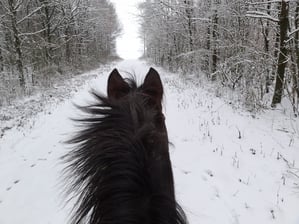Around this time of year, most places in the united states will get hit by some sort of snowfall. Riding in the snow is one of winter’s joys and is a nice change for your horse. However, there are several things to consider before taking your horse out for a snowy ride.  First, how will your horse react to snow? It’s a different surface for him. It looks and feels different – this can be spooky to some horses. If it’s merely a dusting of snow, this might not be an issue. But once it gets up around his knees, it becomes a whole new experience. Introduce him to it the same way you’d do for any new experience.
First, how will your horse react to snow? It’s a different surface for him. It looks and feels different – this can be spooky to some horses. If it’s merely a dusting of snow, this might not be an issue. But once it gets up around his knees, it becomes a whole new experience. Introduce him to it the same way you’d do for any new experience.
Depending on where you live – or how long the snow has been around – there are two kinds of snow: soft and fluffy or packed and icy. Just as skiers and snowboarders love the soft, fluffy snow, this “fluff” is ideal for riding due to its smoothness on trails. However, it can also take more effort for your horse to push his legs through it. It’s important to give your horse a thorough warmup before riding in the snow. This can help prevent sore muscles later. Make sure you know where you are riding as powdery snow can sometimes cover hazards such as large rocks or tree stumps. The good news? It provides for a softer landing if you and your horse “disconnect.”
Packed snow is what you get when you are following a trail made by someone else – another horse, a skier, tractor, SxS, etc. It takes less energy for your horse to walk through it, but can also be more dangerous. Packed snow can turn icy so be aware of the possibility of your horse slipping. Due to the sun and shade provided by trees or other structures, a trail can have stretches of powder AND patches of ice that can come up unexpectedly.
Wetter, icier snow is a prime cause of “ice balls” in your horse’s hoofs. When your horse walks on snow, the heat of his hoof can warm up the snow while the metal from the horseshoe on your horses foot can make it freeze again, causing a buildup. After a while, this turns into an uneven mass that can cause discomfort when walking and possible damage to tendons and joints. There are several ways to help prevent this problem such as, letting your horse go barefoot, using hoof boots, or adding anti-snowball pads.
your horse’s hoofs. When your horse walks on snow, the heat of his hoof can warm up the snow while the metal from the horseshoe on your horses foot can make it freeze again, causing a buildup. After a while, this turns into an uneven mass that can cause discomfort when walking and possible damage to tendons and joints. There are several ways to help prevent this problem such as, letting your horse go barefoot, using hoof boots, or adding anti-snowball pads.
Finally, make sure both you and your horse are dressed for the weather. If you have snow, the temperature is probably already near or below freezing, and riding outside typically means no blocks from the wind, making it even colder. Consider a quarter sheet for your horse’s hindquarters to keep those muscles warm.



